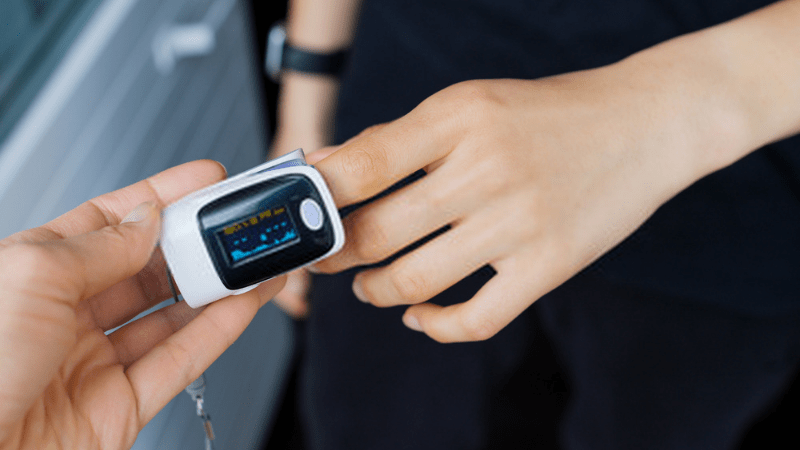To live, every process and organ in the body needs oxygen. Cells begin to fail and ultimately die as they are deprived of oxygen. Cell death will result in serious conditions and in the worst-case situation, organ malfunction – which may sometimes lead to death.
The lungs filter oxygen before delivering it to the body's cells. The lungs then use hemoglobin proteins in red blood cells to transport oxygen into the bloodstream. These proteins carry oxygen across the body.
Pulse oximetry is a pain-free and non-invasive method that calculates your oxygen saturation level or the amount of oxygen in your blood. It can notice even minor differences in the efficiency with which oxygen is transported to the internal organs farthest from the heart, such as the legs and arms.
A pulse oximeter is a thin, clip-like gadget that is worn on a body part such as the fingertips or earlobe. It's usually worn on a finger and is frequently utilized in critical healthcare settings such as emergency departments and hospitals.
It can be used in the office too by physicians for quick diagnosis, say of diseases like pulmonologists. You might like to find the best pulse oximeter in India to check oxygen saturation levels effortlessly that will help you to live the healthy, active, and tension-free life you deserve.
Purpose and Uses
Pulse oximetry is a procedure that measures how efficiently the heart pumps oxygen into your body.
It can be utilized to track the health of people suffering from any disorder that affects blood oxygen levels – and can be used easily in hospital, clinical, domestic and other commercial settings. Here are some of the disorders that can affect the oxygen levels in your body:
- Lung cancer
- Suffocation
- Allergic reactions
- Heart attack
- Drowning
- Anemia
- Lung disease
- Pneumonia
Pulse oximetry is utilized in a number of cases, including the following:
- to see how good a new lung drug is performing
- to see if anyone needs support breathing
- to see how effective a ventilator is
- to keep an eye on oxygen levels before or after sedation-induced surgery
- to see how successful additional oxygen therapy is, particularly when it's being used for the first time
- to determine a person's tolerance for excessive physical activity
- During a sleep test, to see whether anyone temporarily stops breathing during sleeping
Readings
Pulse oximetry is a reasonably reliable test in most cases. This is particularly true when working with high-quality instruments like those used in most medical offices and hospitals. It frequently produces results that are within a 2-percent range of what it actually is.
Your accurate oxygen saturation level could be somewhere between 86 and 90 percent if your measurement was 88 percent. However, the waveform's consistency and the person's evaluation must be taken into account. Motion, temperature, and nail polish can all influence precision.
More than 89 percent of the blood must be holding oxygen in most healthy situations. This is the oxygen saturation level that your organs and your body require to remain well. While possessing an oxygen saturation underneath this level for a short period of time is unlikely to cause harm, repeated or persistent low oxygen saturation rates can be harmful.
For most fit individuals, an oxygen saturation rate of 95% is deemed natural. A 92 percent oxygen saturation level indicates probable hypoxemia or a lack of oxygen flowing to body tissues.
Working
A tiny clamp-like gadget is mounted on a finger, earlobe, or toes during a pulse oximetry recording. The level of oxygen in the finger is measured via narrow rays of light passing through the blood. It achieves so by detecting differences in light absorption in oxygenated and deoxygenated blood. This is a simple procedure.
As a result, the pulse oximeter will inform you your oxygen saturation level as well as your heart rate. As per the World Health Organization, there are a few excellent ways to having the most precise readings on a pulse oximeter:
- This is normally on a finger, toes, or earlobe, based on the unit. Make sure it fits correctly and isn't being pushed on: for instance, try it on your second toe rather than your big toe. If the probe is not properly fixed or is too tight, additional light can enter, affecting the reading.
- The reading can be influenced by trembling or shivering, and it can appear significantly lower than it really is.
- If you have colorful nail polish on, the reading can be affected. Finger tattoos or henna color may also influence the accuracy, so use a different finger, toe, or earlobe in this situation. Wrong readings may also be caused by cold fingers or toes.
We, at Lifestyle Titbits, assume that this comprehensive information would have helped you in understanding the working and uses of a pulse oximeter. Keep visiting us for more useful titbits that will empower you to live the fit, disease-free, and serene life you deserve.

